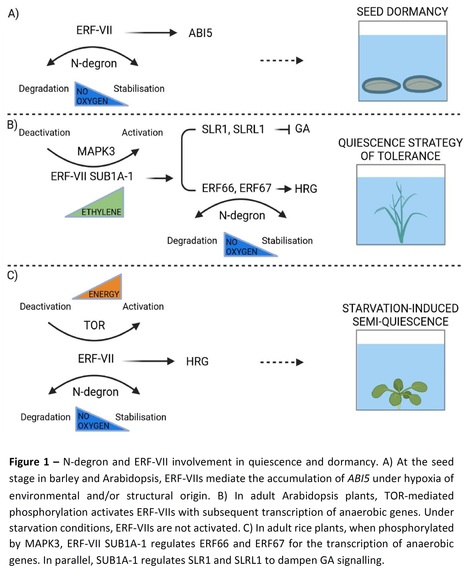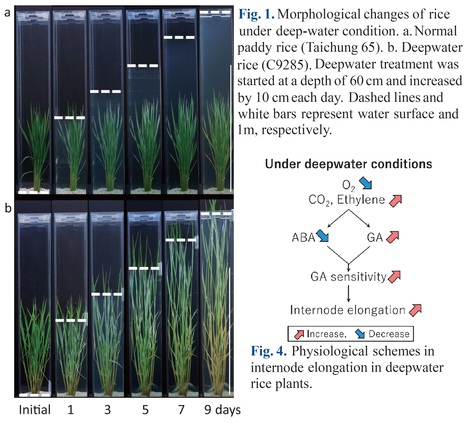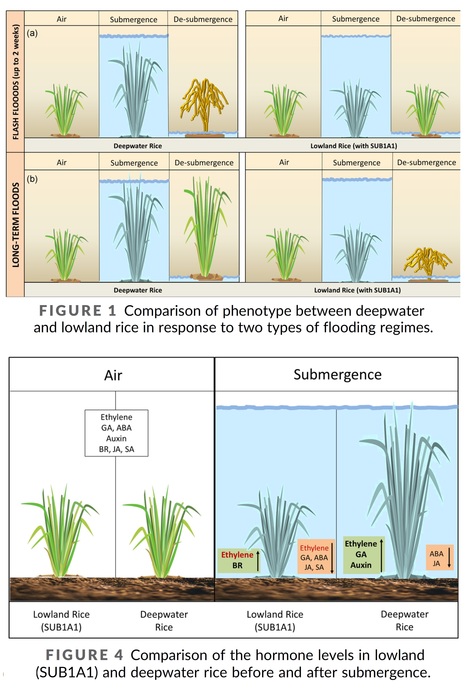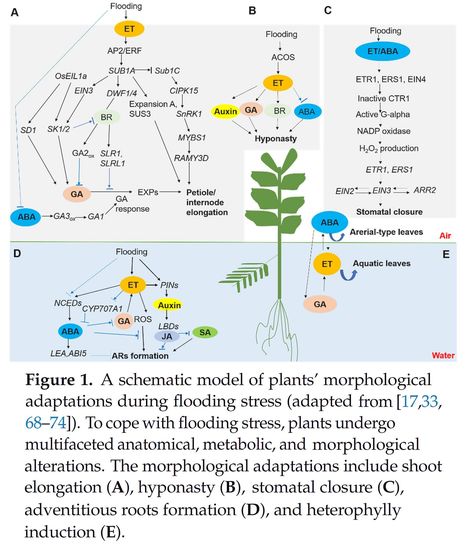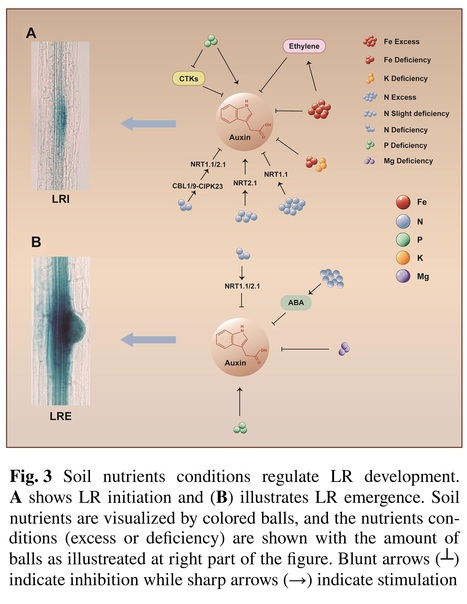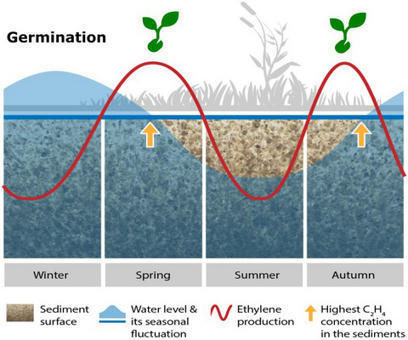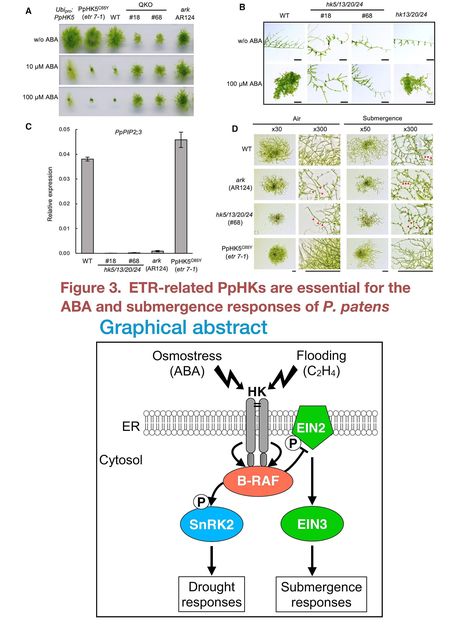 Your new post is loading...
 Your new post is loading...
Authors: Sahana Basu, Monika, Surbhi Kumari and Gautam Kumar.
Plant Physiology and Biochemistry (2024)
Highlights: • IAA induces lateral root formation in rice under submergence • ROS and RNS cause lysigenous aerenchyma formation in root cortex of rice • Submergence decreases ABA level, causing GA-mediated escape response in rice shoot • Enhanced antioxidant levels dampen nitro-oxidative damage during de-submergence
Abstract: "Constant change in global climate has become the most important limiting factor to crop productivity. Asymmetrical precipitations are causing recurrent flood events around the world. Submergence is one of the most detrimental abiotic stresses for sustainable rice production in the rainfed ecosystems of Southeast Asia. Therefore, the development of submergence-tolerant rice is an essential requirement to encounter food security. Submergence tolerance in rice is governed by the major quantitative trait locus (QTL) designated as Submergence1 (Sub1) near the centromere of chromosome 9. The introduction of the Sub1 in high-yielding rice varieties producing near-isogenic lines (NILs) has shown extreme submergence tolerance. The present study aimed to understand the responses of rice genotype IR64 and its Sub1 NIL IR64 Sub1 following one week of complete submergence treatment. Submergence imposed severe nitro-oxidative stress in both the rice genotypes, consequently disrupting the cellular redox homeostasis. In this study, IR64 exhibited higher NADPH oxidase activity accompanied by increased reactive oxygen species, reactive nitrogen species, and malondialdehyde buildups and cell death under submergence. Higher accumulations of 1-Aminocyclopropane-1-carboxylic acid, gibberellic acid, and Indole-3-acetic acid were also observed in IR64 which accelerated the plant growth and root cortical aerenchyma development following submergence. In contrast, IR64 Sub1 had enhanced submergence tolerance associated with an improved antioxidant defense system with sustainable morpho-physiological activities and restricted root aerenchyma formation. The comprehensive analyses of the responses of rice genotypes with contrasting submergence tolerance may demonstrate the intricacies of rice under complete submergence and may potentially contribute to improving stress resilience by advancing our understanding of the mechanisms of submergence tolerance in rice."
Authors: Chiara Pucciariello and Pierdomenico Perata.
Journal of Experimental Botany (2024)
Abstract: "Plant quiescence and seed dormancy can be triggered by reduced oxygen availability. Under water, oxygen depletion caused by flooding can culminate in a quiescent state, which is a plant strategy for energy preservation and survival. In adult plants, a quiescent state can be activated by sugar starvation, culminating in metabolic depression. In seeds, secondary dormancy can be activated by reduced oxygen availability, which creates an unfavourable state for germination. The physical dormancy of some seeds and buds includes barriers to external conditions, which indirectly results in hypoxia. The molecular processes that support seed dormancy and plant survival through quiescence under hypoxia include the N-degron pathway, which enables the modulation of ethylene responsive factors of group VII and downstream targets. This oxygen- and nitric oxide-dependent mechanism interacts with phytohormone-related pathways to control growth."
Authors: Jagannath Swain, Vinay Shukla, Francesco Licausi and Kapuganti Jagadis Gupta.
Trends in Plant Science (2024)
Abstract: "Group VII ethylene-responsive factor (ERFVII) transcription factors are crucial for the adaption of plants to conditions that limit oxygen availability. A recent study by Zubrycka et al. reveals new aspects of ERFVII stabilization through the PLANT CYSTEINE OXIDASE (PCO)-N degron pathway and non-autonomous regulation in response to different endogenous and exogenous cues."
Authors: Kevin Daniel and Sjon Hartman.
Journal of Experimental Botany (2024)
Abstract: "Plant submergence is a major abiotic stress that impairs plant performance. Underwater, reduced gas diffusion exposes submerged plant cells to an environment that is enriched in gaseous ethylene and is limited in oxygen (O2) availability (hypoxia). The capacity for plant roots to avoid and/or sustain critical hypoxia damage is essential for plants to survive waterlogging. Plants use spatiotemporal ethylene and O2 dynamics as instrumental flooding signals to modulate potential adaptive root growth and hypoxia stress acclimation responses. However, how non-adapted plant species modulate root growth behaviour during actual waterlogged conditions to overcome flooding stress has hardly been investigated. Here we discuss how changes in the root growth rate, lateral root formation, density and growth angle of non-flood adapted plant species (mainly Arabidopsis) could contribute to avoiding and enduring critical hypoxic conditions. In addition, we discuss the current molecular understanding of how ethylene and hypoxia signalling control these adaptive root growth responses. We propose that future research would benefit from less artificial experimental designs to better understand how plant roots respond to and survive waterlogging. This acquired knowledge would be instrumental to guide targeted breeding of flood-tolerant crops with more resilient root systems."
Authors: Hendrika A.C.F. Leeggangers, Natalia Yaneth Rodriguez-Granados, Monika Gyöngyi Macias-Honti and Rashmi Sasidharan.
Environmental and Experimental Botany (2023)
Highlights: • Ethylene is a major hormonal regulator of plant responses to flooding stress. • Soil flooding or waterlogging elicits various morphological or metabolic adaptations to escape/cope with flooding-associated hypoxia. • Ethylene regulates many survival traits, either locally triggering root responses or long-distance signal for shoot responses. • The versatile role of ethylene in plant responses to waterlogging can be attributed to various factors.
Abstract: "Ethylene plays a very important role as a stress signal for flooded plants, triggering a range of morphological and metabolic changes that help plants acclimate and survive these conditions. The present review surveys the current knowledge on the mechanisms underlying ethylene-dependent survival responses to waterlogging. We untangle the complexity of waterlogging signaling and response, focusing on root and shoot acclimation strategies mediated by ethylene. We describe how ethylene can have versatile roles in waterlogging tolerance, acting both as a local and long-distance signal during soil flooding and reoxygenation. We discuss the internal and external factors contributing to ethylene versatility in waterlogging responses. Finally, we highlight the current challenges and future research directions in the field, focusing not only on ethylene-mediated responses but also on flooding research applications in crop improvement."
Authors: Keisuke Nagai and Motoyuki Ashikari
Breeding Science (2023)
Abstract: "Rice plants that form ventilated tissues, such as aerenchyma in the leaves, stems, and roots, allow for growth in waterlogged conditions (paddy fields), but they cannot breathe and drown in flooded environments where the whole plant body is submerged. However, deepwater rice plants grown in flood-prone areas of Southeast Asia survive in prolonged flooded environments by taking in air through an elongated stem (internode) and leaves that emerge above the water surface, even if the water level is several meters high and flooding continues for several months. Although it has been known that plant hormones, such as ethylene and gibberellins, promote internode elongation in deepwater rice plants, the genes that control rapid internode elongation during submergence have not been identified. We recently identified several genes responsible for the quantitative trait loci involved in internode elongation in deepwater rice. Identification of the genes revealed a molecular gene network from ethylene to gibberellins in which internode elongation is promoted by novel ethylene-responsive factors and enhances gibberellin responsiveness at the internode. In addition, elucidation of the molecular mechanism of internode elongation in deepwater rice will help our understanding of the internode elongation mechanism in normal paddy rice and contribute to improving crops through the regulation of internode elongation."
Authors: Jian Sun, Guangchen Zhang, Zhibo Cui, Ximan Kong, Xiaoyu Yu, Rui Gui, Yuqing Han, Zhuan Li, Hong Lang, Yuchen Hua, Xuemin Zhang, Quan Xu, Liang Tang, Zhengjin Xu, Dianrong Ma and Wenfu Chen.
Nature Communications (2022)
Editor's view: Waterlogging tolerance is important in direct seeding rice cultivation practice. Here, the authors identify a 14-3-3 protein-coding gene OsGF14h in weedy rice that confers anaerobic germination and anaerobic seedling development tolerance by balancing ABA signaling and GA biosynthesis."
Abstract: "Contemporary climatic stress seriously affects rice production. Unfortunately, long-term domestication and improvement modified the phytohormones network to achieve the production needs of cultivated rice, thus leading to a decrease in adaptation. Here, we identify a 14-3-3 protein-coding gene OsGF14h in weedy rice that confers anaerobic germination and anaerobic seedling development tolerance. OsGF14h acts as a signal switch to balance ABA signaling and GA biosynthesis by interacting with the transcription factors OsHOX3 and OsVP1, thereby boosting the seeding rate from 13.5% to 60.5% for anaerobic sensitive variety under flooded direct-seeded conditions. Meanwhile, OsGF14h co-inheritance with the Rc (red pericarp gene) promotes divergence between temperate japonica cultivated rice and temperate japonica weedy rice through artificial and natural selection. Our study retrieves a superior allele that has been lost during modern japonica rice improvement and provides a fine-tuning tool to improve flood adaptation for elite rice varieties."
Author: José Manuel Ugalde.
Plant Physiology (2022)
Excerpts: "In this issue of Plant Physiology, (Liu et al., 2022) studied the mechanisms by which ethylene pre-treatments help Arabidopsis root tip survival during hypoxia and re-oxygenation. Because re-oxygenation after hypoxia triggers a ROS burst that could damage the cell, the authors evaluated cell viability at different recovery timepoints after a four-hour hypoxia treatment."
"Most of the genes differentially expressed during hypoxia were already differentially expressed immediately after the ethylene pre-treatment, indicating that ethylene signaling triggers a transcriptome reconfiguration maintained during hypoxia. Enriched gene ontology (GO) terms of genes upregulated by ethylene treatments were linked to hypoxia response and abscisic acid (ABA), among others. In comparison, GO terms enriched in the downregulated genes were related to decreased cellular maintenance and root growth, such as PLETHORA (PLT) 1 and 2, SCARECROW (SCR), and SHORTROOT (SHR). Moreover, ethylene limited the expression of genes related to ROS homeostasis and antioxidant activity, such as peroxidases like ASCORBATE PEROXIDASE 2 (APX2) (Figure 1)."
Authors: Haipei Liu, Amanda J. Able and Jason A. Able.
Trends in Plant Science (2022)
Highlights: Plants have stress memories that lead to epigenetic, transcriptomic, proteomic, and metabolomic changes, enabling enhanced responses to additional stress exposure. Multi-omic studies have identified previously unrecognised regulators, metabolites, and pathways as key components of priming-induced thermotolerance. Successful acclimation for drought and flooding-induced stress memory is linked to changes in antioxidative capacity, biochemical modifications, and hormone pathways. Cross-stress tolerance can be elicited by pre-exposure of a primary stress to improve crop performance under subsequent stress. Application of priming agents is another effective cross-priming approach, particularly for seed priming or commercial seed production. Cross-stress priming success relies on synergistic stress signalling pathways being shared across stresses varying in nature and intensity.
Abstract: "The agricultural sector must produce resilient and climate-smart crops to meet the increasing needs of global food production. Recent advancements in elucidating the mechanistic basis of plant stress memory have provided new opportunities for crop improvement. Stress memory-coordinated changes at the organismal, cellular, and various omics levels prepare plants to be more responsive to reoccurring stress within or across generation(s). The exposure to a primary stress, or stress priming, can also elicit a beneficial impact when encountering a secondary abiotic or biotic stress through the convergence of synergistic signalling pathways, referred to as cross-stress tolerance. ‘Rewired plants’ with stress memory provide a new means to stimulate adaptable stress responses, safeguard crop reproduction, and engineer climate-smart crops for the future."
Authors: Rainer Waadt, Charles A. Seller, Po-Kai Hsu, Yohei Takahashi, Shintaro Munemasa and Julian I. Schroeder.
Nature Reviews Molecular Cell Biology (2022)
Editor's view: Abiotic stresses, such as drought, salinity, heat, cold and flooding, have profound effects on plant growth and survival. Adaptation and tolerance to such stresses require sophisticated sensing, signalling and stress response mechanisms. Schroeder and colleagues discuss recent insights into how plant hormones control such responses. Understanding these mechanisms opens opportunities for agricultural applications.
Abstract: "Plant hormones are signalling compounds that regulate crucial aspects of growth, development and environmental stress responses. Abiotic stresses, such as drought, salinity, heat, cold and flooding, have profound effects on plant growth and survival. Adaptation and tolerance to such stresses require sophisticated sensing, signalling and stress response mechanisms. In this Review, we discuss recent advances in understanding how diverse plant hormones control abiotic stress responses in plants and highlight points of hormonal crosstalk during abiotic stress signalling. Control mechanisms and stress responses mediated by plant hormones including abscisic acid, auxin, brassinosteroids, cytokinins, ethylene and gibberellins are discussed. We discuss new insights into osmotic stress sensing and signalling mechanisms, hormonal control of gene regulation and plant development during stress, hormone-regulated submergence tolerance and stomatal movements. We further explore how innovative imaging approaches are providing insights into single-cell and tissue hormone dynamics. Understanding stress tolerance mechanisms opens new opportunities for agricultural applications."
Authors: Lavanya Mittal, Sumaira Tayyeba and Alok K. Sinha.
Plant, Cell & Environment (2022)
Review: "During the course of evolution, different ecotypes of rice (Oryza sativa L.) have evolved distinct strategies to cope with submergence stress. Such contrasting responses are mediated by plant hormones that are principle regulators of growth, development and responses to various biotic and abiotic stresses. These hormones act cooperatively and show extensive crosstalk which is mediated by key regulatory genes that serve as nodes of molecular communication. The presence or absence of such genes leads to significant changes in hormone signalling pathways and hence, governs the type of response that the plant will exhibit. As flooding is one of the leading causes of crop loss across all the major rice-producing countries, it is crucial to deeply understand the molecular nexus governing the response to submergence to produce flood resilient varieties. This review focuses on the hormonal signalling pathways that mediate two contrasting responses of the rice plant to submergence stress namely, rapid internode elongation to escape flood waters and quiescence response that enables the plant to survive under complete submergence. The significance of several key genes such as Sub1A-1, SLR1, SD1 and SK1/SK2, in defining the ultimate response to submergence has also been discussed."
Authors: Malay Kumar Adak, Indraneel Saha, Debabrata Dolui and Mirza Hasanuzzaman.
Frontiers in Bioscience (2021)
Abstract: "Waterlogging or flooding in agricultural soil constructs a complex abiotic stress-web in crop plants throughout the lowland agricultural system. In rice, a staple grain crop in the world, submergence creates a long-term and recurrent problem for crops withstanding and their succeeding productivity. Therefore, to restore a satisfactory yield instead of a failure of crop in such submerged areas, the analysis of plants’ responses is important. Such analysis will facilitate research about the entity components of plants responses to anoxia or submergence. For example, the development of cellular and molecular cascade in gene expression of ROS signaling and its subsequent responses may lead to either tolerance or susceptibility in plants. Interplay of plant growth regulators [e.g., ethylene (ET), abscisic acid (ABA), gibberellic acid (GA) etc.] is the well-recognized residues in the coordination of signaling, its transmission through cellular network, and finally, modulation of gene expression are the keys to such tolerance. Nucleotide elements that are specifically sensitive to ethylene have been rescued from land-races of aus-type group of rice (Oryza sativa) and those are considered as the prime determinants for tolerance against anoxia. In this comprehensive text, we tried to accommodate and revise the fundamental and pivotal mechanisms of submergence stress at different angles of physiological and cellular responses of plants. These have also been reviewed for modern state of art techniques deciphering the molecular rejoinders like microRNA, protein-protein interaction, feedback regulation of expression, sugar sensing, amplification of elicitor’s responses and others. Finally, strategies including physiological selection, metabolic engineering, marker assisted selection, genetical manipulation, interspecific hybridization are involved in developing stress resilience and plants’ architecture to support sustainable agriculture under lowland systems."
Authors: Yancui Zhao, Wenying Zhang, Salah Fatouh Abou-Elwafa, Sergey Shabala and Le Xu
Plants (2021)
Abstract: "Soil flooding severely impairs agricultural crop production. Plants can cope with flooding conditions by embracing an orchestrated set of morphological adaptations and physiological adjustments that are regulated by the elaborated hormonal signaling network. The most prominent of these hormones is ethylene, which has been firmly established as a critical signal in flooding tolerance. ABA (abscisic acid) is also known as a “stress hormone” that modulates various responses to abiotic stresses; however, its role in flooding tolerance remains much less established. Here, we discuss the progress made in the elucidation of morphological adaptations regulated by ABA and its crosstalk with other phytohormones under flooding conditions in model plants and agriculturally important crops."
|
Authors: Minmin He, Gui Geng, Shuyang Mei, Gang Wang, Lihua Yu, Yao Xu and Yuguang Wang.
Functional Plant Biology (2024)
Abstract: "Water stress (drought and waterlogging) leads to an imbalance in plant water distribution, disrupts cell homeostasis, and severely inhibits plant growth. Melatonin is a growth hormone that plants synthesise and has been shown to resist adversity in many plants. This review discusses the biosynthesis and metabolism of melatonin, as well as the changes in plant morphology and physiological mechanisms caused by the molecular defence process. Melatonin induces the expression of related genes in the process of plant photosynthesis under stress and protects the structural integrity of chloroplasts. Exogenous melatonin can maintain the dynamic balance of root ion exchange under waterlogging stress. Melatonin can repair mitochondria and alleviate damage caused by reactive oxygen species and reactive nitrogen species; and has a wide range of uses in the regulation of stress-specific genes and the activation of antioxidant enzyme genes. Melatonin improves the stability of membrane lipids in plant cells and maintains osmotic balance by regulating water channels. There is crosstalk between melatonin and other hormones, which jointly improve the ability of the root system to absorb water and breathe and promote plant growth. Briefly, as a multifunctional molecule, melatonin improves the tolerance of plants under water stress and promotes plant growth and development."
Authors: Petar Mohorović, Batist Geldhof, Kristof Holsteens, Marilien Rinia, Johan Ceusters and Bram Van de Poel.
Plant Direct (2023)
Abstract: "Salinity, drought, and waterlogging are common environmental stresses that negatively impact plant growth, development, and productivity. One of the responses to abiotic stresses is the production of the phytohormone ethylene, which induces different coping mechanisms that help plants resist or tolerate stress. In this study, we investigated if an ethylene pretreatment can aid plants in activating stress-coping responses prior to the onset of salt, drought, and waterlogging stress. Therefore, we measured real-time transpiration and CO2 assimilation rates and the impact on biomass during and after 3 days of abiotic stress. Our results showed that an ethylene pretreatment of 1 ppm for 4 h did not significantly influence the negative effects of waterlogging stress, while plants were more sensitive to salt stress as reflected by enhanced water losses due to a higher transpiration rate. However, when exposed to drought stress, an ethylene pretreatment resulted in reduced transpiration rates, reducing water loss during drought stress. Overall, our findings indicate that pretreating tomato plants with ethylene can potentially regulate their responses during the forthcoming stress period, but optimization of the ethylene pre-treatment duration, timing, and dose is needed. Furthermore, it remains tested if the effect is related to the stress duration and severity and whether an ethylene pretreatment has a net positive or negative effect on plant vigor during stress recovery. Further investigations are needed to elucidate the mode of action of how ethylene priming impacts subsequent stress responses."
Authors: Sidra Javed, Xiangzheng Chai, Xiaoming Wang and Shengbao Xu.
Plant and Soil (2023)
Abstract: "Background - Plants rely heavily on the formation of post-embryonic organs, such as leaves, branches, and lateral roots, to adapt to varying soil conditions. Lateral roots (LR) play a crucial role in the plant root system, serving as the primary factor in the exploration of water and nutrients in the soil. The development of LR is meticulously controlled by phytohormones to respond to the information obtained from the surrounding soil. This regulation ensures an optimal arrangement of lateral roots, enabling efficient nutrient absorption and adaptation to the challenging environmental conditions. Scope - This review summarizes recent progress in understanding the mechanisms of lateral root layout in different soil micro-environments and the role of phytohormones in mediating LR development for soil adaptation. Conclusions - The intricate signaling network governing LR layout involves interactions among various soil factors, which are mediated by phytohormones. Despite its complexity, recent studies have yielded significant insights that can be applied to optimize LR arrangement in soil profiles through genetic and cultivation methods to enhance crop yield and stress tolerance."
Authors: Zhirui Yang, Yibo Cao, Yiting Shi, Feng Qin, Caifu Jiang and Shuhua Yang.
Molecular Plant (2023)
Abstract: "Global climate change exacerbates the effects of environmental stressors, such as drought, flooding, extreme temperatures, salinity and alkalinity, on crop growth and grain yield, threatening the sustainability of the food supply. Maize (Zea mays) is one of the most widely cultivated crops and the most abundant grain crop in production worldwide. However, maize yield stability is highly dependent on environmental conditions. Recently, great progress has been achieved in understanding the molecular mechanisms underlying maize responses to environmental stresses and developing stress-resilient varieties through the rapid advancement of high-throughput sequencing technologies, multi-omics analytic platforms and automated phenotyping facilities. In this review, we summarize recent advances in dissecting the genetic components contributing to maize abiotic stress tolerance through diverse genetic strategies. In addition, we discuss the future challenges and opportunities for developing climate-resilient maize varieties".
Authors: Yiyi Zhang, Yuanfu Xie, Haifan Shi, Yufen Zhuang, Yuan Zheng, Honghui Lin and Huapeng Zhou.
Plant and Cell Physiology (2023)
Abstract: "Floods impose detrimental effects on natural and agro-ecosystems, leading to significant loss of worldwide crop production. Global climate change has even strengthened this situation. Flooding is a continuous process including two stages of submergence and re-oxygenation, and both are harmful to plant growth and development, resulting in a serious decline on crop yield. Therefore, the understanding of plant flooding tolerance and developing flooding-resistant crops are of great significance. Here, we report that the Arabidopsis thaliana (Arabidopsis) R2R3-MYB transcription factor MYB30 participates in plant submergence response through ACS7 by repressing ethylene (ET) biosynthesis. The MYB30 loss-of-function mutant exhibits reduced submergence tolerance with higher level of ET production, whereas the MYB30-overexpressing plant displays enhanced submergence tolerance and repressed ET production. The coding gene of ACC synthase 7 (ACS7) might be a direct target of MYB30 during submergence response. MYB30 binds to the promoter of ACS7 and represses its transcription. ACS7 loss-of-function mutant with defect in ET biosynthesis displays enhanced submergence tolerance, whereas plants overexpressing ACS7 exhibit a submergence-sensitive phenotype. Genetic analysis shows that ACS7 functions downstream of MYB30 both in ET biosynthesis and submergence response. Taken together, our work revealed a novel transcriptional regulation that modulates submergence response in plants."
Authors: Tom Rankenberg, Hans van Veen, Mastoureh Sedaghatmehr, Che-Yang Liao, Muthanna Biddanda Devaiah, Salma Balazadeh and Rashmi Sasidharan.
bioRxiv (2022)
Abstract: "The volatile phytohormone ethylene is a major regulator of plant adaptive responses to flooding. In flooded plant tissues, it quickly increases to high concentrations due to its low solubility and diffusion rates in water. The passive, quick and consistent accumulation of ethylene in submerged plant tissues makes it a reliable cue for plants to trigger flood-acclimative responses. However, persistent ethylene accumulation can also have negative effects, notably accelerated leaf senescence. Ethylene is a well-established positive regulator of senescence which is a natural element of plant ageing. However stress-induced senescence hampers the photosynthetic capacity and stress recovery of plants. In submerged Arabidopsis shoots, senescence follows a strict age-dependent pattern starting with the older leaves. Although mechanisms underlying ethylene-mediated senescence have been uncovered, it is unclear how submerged plants avoid an indiscriminate breakdown of leaves despite high systemic accumulation of ethylene. Here we demonstrate in Arabidopsis plants that even though submergence triggers a leaf-age independent activation of ethylene signaling via EIN3, senescence was initiated only in the old leaves. This EIN3 stabilization also led to the overall transcript and protein accumulation of the senescence-promoting transcription factor ORESARA1 (ORE1). ORE1 protein accumulated in both old and young leaves during submergence. However, leaf age-dependent senescence could be explained by ORE1 activation via phosphorylation only in old leaves. Our results unravel a mechanism by which plants regulate the speed and pattern of senescence during environmental stresses like flooding. Such an age-dependent phosphorylation of ORE1 ensures that older expendable leaves are dismantled first, thus prolonging the life of younger leaves and meristematic tissues vital to whole plant survival."
Authors: Aida Maric and Sjon Hartman.
The EMBO Journal (2022)
Abstract: Protein synthesis is an essential but energetically expensive cellular process that is challenged under environmental stress in plants. Recent work demonstrates that the plant hormone ethylene, through GCN2, represses general translation during flooding stress to conserve energy. Moreover, ethylene also promotes the translation of specific stress-responsive mRNAs to survive submergence stress.
Authors: Xin Wang and Setsuko Komatsu
Frontiers in Plant Science (2022)
Abstract: "Climatic variations influence the morphological, physiological, biological, and biochemical states of plants. Plant responses to abiotic stress include biochemical adjustments, regulation of proteins, molecular mechanisms, and alteration of post-translational modifications, as well as signal transduction. Among the various abiotic stresses, flooding stress adversely affects the growth of plants, including various economically important crops. Biochemical and biological techniques, including proteomic techniques, provide a thorough understanding of the molecular mechanisms during flooding conditions. In particular, plants can cope with flooding conditions by embracing an orchestrated set of morphological adaptations and physiological adjustments that are regulated by an elaborate hormonal signaling network. With the help of these findings, the main objective is to identify plant responses to flooding and utilize that information for the development of flood-tolerant plants. This review provides an insight into the role of phytohormones in plant response mechanisms to flooding stress, as well as different mitigation strategies that can be successfully administered to improve plant growth during stress exposure. Ultimately, this review will expedite marker-assisted genetic enhancement studies in crops for developing high-yield lines or varieties with flood tolerance."
Authors: Hsing-Yi Cho, Mei-Yi Chou, Hsiu-Yin Ho, Wan-Chieh Chen and Ming-Che Shih.
Science Advances (2022)
One-sentence summary: A noncanonical ethylene signaling pathway triggers GCN2 to modulate translation dynamics in Arabidopsis during submergence.
Abstract: "General translational repression is a key process that reduces energy consumption under hypoxia. Here, we show that plant stress-activated general control nonderepressible 2 (GCN2) was activated to regulate the reduction in polysome loading during submergence in Arabidopsis. GCN2 signaling was activated by ethylene under submergence. GCN2 activity was reduced in etr1-1, but not in ein2-5 or eil1ein3, under submergence, suggesting that GCN2 activity is regulated by a noncanonical ethylene signaling pathway. Polysome loading was not reduced in ein2-5 under submergence, implying that ethylene modulates translation via both EIN2 and GCN2. Transcriptomic analysis demonstrated that EIN2 and GCN2 regulate not only general translational repression but also translational enhancement of specific mRNAs under submergence. Together, these results demonstrate that during submergence, entrapped ethylene triggers GCN2 and EIN2 to regulate translation dynamics and ensure the translation of stress response proteins."
Authors: S. S. Phartyal, S. Rosbakh, M. Gruber and P. Poschlod.
Plant Biology (2022)
Editor's view: Biogenic ethylene fine-tunes plant recruitment in wetlands by synchronising seed germination to the most optimal place and time for seedling establishment.
Abstract: "Wetlands are known for comparatively high production of biogenic ethylene from decomposed sediment. Because the gas has various well-documented effects on seed physiology, we asked whether it can be a vital seed germination cue for wetland plants. Specifically, we explored whether ethylene plays an ecological role in (i) breaking/weakening seed dormancy, (ii) broadening the germination niche width, (iii) promoting germination speed or (iv) altering the germination requirements of six plant species with different occurrence along a hydroperiod gradient. In a factorial experiment, both ethylene-treated and untreated seeds were incubated in combinations of temperature (constant versus fluctuating), illumination (light versus darkness) and oxygen (aerobic versus hypoxia) with and without cold stratification. Our results revealed seed exposure to ethylene did not weaken or break dormancy without cold stratification treatment. However, ethylene helped to broaden the germination niche width, increased overall germination percentage and speed of cold-stratified (non-dormant) seeds. This indicates that ethylene helps those seeds that lost dormancy (non-dormant) to sense favourable water-saturated versus flooded substrate depending on their requirement for aerobic versus hypoxic conditions to trigger germination. We conclude that ethylene does not interfere directly with the dormancy-breaking process in autumn-dispersed seeds that are naturally cold-stratified in winter and germinate in spring/summer. However, ethylene plays a crucial ecological role as a ‘flood detector' for different wetland plant communities (reed, mudflat, swamp, shallow water) to synchronize germination of non-dormant seeds in the most suitable habitat at the right time."
Authors: Hao Chen, David A. Bullock, Jr., Jose M. Alonso and Anna N. Stepanova.
Plants (2022)
Abstract: "Plants often live in adverse environmental conditions and are exposed to various stresses, such as heat, cold, heavy metals, salt, radiation, poor lighting, nutrient deficiency, drought, or flooding. To adapt to unfavorable environments, plants have evolved specialized molecular mechanisms that serve to balance the trade-off between abiotic stress responses and growth. These mechanisms enable plants to continue to develop and reproduce even under adverse conditions. Ethylene, as a key growth regulator, is leveraged by plants to mitigate the negative effects of some of these stresses on plant development and growth. By cooperating with other hormones, such as jasmonic acid (JA), abscisic acid (ABA), brassinosteroids (BR), auxin, gibberellic acid (GA), salicylic acid (SA), and cytokinin (CK), ethylene triggers defense and survival mechanisms thereby coordinating plant growth and development in response to abiotic stresses. This review describes the crosstalk between ethylene and other plant hormones in tipping the balance between plant growth and abiotic stress responses."
Authors: Tsukasa Toriyama, Akihisa Shinozawa, Yuki Yasumura, Masashi Saruhashi, Mayuka Hiraide, Shiori Ito, Hideyuki Matsuura, Keiko Kuwata, Mika Yoshida, Tadashi Baba, Izumi Yotsui, Teruaki Taji, Daisuke Takezawa and Yoichi Sakata.
Current Biology (2022)
Editor's view: Toriyama et al. show that, in the moss Physcomitrium patens, ethylene-receptor- related sensor histidine kinases (HKs) interact with a Raf kinase (RAF) at the endoplasmic reticulum. This HK-RAF module is essential for ethylene-mediated submergence signaling and abscisic-acid-mediated osmostress signaling for optimal environmental stress responses.
Highlights: • Ethylene-receptor-related histidine kinases are essential for moss stress responses • ETR-HKs interact with a RAF kinase at the endoplasmic reticulum • ETR-HKs regulate ABA-dependent activation of SnRK2 via RAF kinase activation
Abstract: "To survive fluctuating water availability on land, terrestrial plants must be able to sense water stresses, such as drought and flooding. The plant hormone abscisic acid (ABA) and plant-specific SNF1-related protein kinase 2 (SnRK2) play key roles in plant osmostress responses. We recently reported that, in the moss Physcomitrium patens, ABA and osmostress-dependent SnRK2 activation requires phosphorylation by an upstream RAF-like kinase (ARK). This RAF/SnRK2 module is an evolutionarily conserved mechanism of osmostress signaling in land plants. Surprisingly, ARK is also an ortholog of Arabidopsis CONSTITUTIVE RESPONSE 1 (CTR1), which negatively regulates the ethylene-mediated submergence response of P. patens, indicating a nexus for cross-talk between the two signaling pathways that regulate responses to water availability. However, the mechanism through which the ARK/SnRK2 module is activated in response to water stress remains to be elucidated. Here, we show that a group of ethylene-receptor-related sensor histidine kinases (ETR-HKs) is essential for ABA and osmostress responses in P. patens. The intracellular kinase domain of an ETR-HK from P. patens physically interacts with ARK at the endoplasmic reticulum in planta. Moreover, HK disruptants lack ABA-dependent autophosphorylation of the critical serine residue in the activation loop of ARK, leading to loss of SnRK2 activation in response to ABA and osmostress. Collectively with the notion that ETR-HKs participate in submergence responses, our present data suggest that the HK/ARK module functions as an integration unit for environmental water availability to elicit optimized water stress responses in the moss P. patens."
|




 Your new post is loading...
Your new post is loading...

